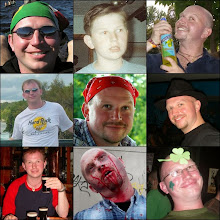A brief interlude in Tilcara
A very cold awakening - the first time this trip that I had not wanted to get out of my bed due to the conditions outside of it rather than those inside. I was up earlier than normal for me again, this time in an attempt to get a bus to the little mountain village of Iruya, which I had been informed was exceedingly pretty. Unfortunately, it appeared this opinion was shared by a certain number of other travellers and a lot of locals, as the buses were full. Time for Plan B. On the recommendation of other friends who'd been to the region I headed back down the gorge a little way to the village of Tilcara.
Tilcara is slightly bigger than my base in Humahuaca, and is notable for the ruins of a large pre-Conquest (mostly Incan) fortress on the outskirts, the Pucara (this apparently is just the word for "fortress" in Quechua, the Inca language), which I promptly climbed up to on arrival, having fortified myself with water and prepared to run the gauntlet of the dust and the village's pack of stray dogs (everywhere here seems to have them, generally harmless but enough to make me nervous given that the Rabies jab is one of the group I've never had). To be honest, the actual remnants are just baselines of walls and the like of dry-stone construction, and everything that can actually be looked around to give a proper impression is 20th-Century reconstruction, mostly from the 30s and 50s. It does give a great view over the valley, though, and is free to visit.
Having worked up a bit of an appetite, I headed back into the village and made my way to a little restaurant called Patio de Comida, where I gorged myself on llama schnitzel and potato salad. Thus sated, I explored the local craft market for a bit, finding numerous things that would potentially be quite pretty back home, but none of them that I wanted enough to actually buy them and then carry them halfway around the continent. By around mid-afternoon it was time to head back to Humahuaca, where I racked up a bit more internet time (there honestly isn't that much to see or do in the village). Dinner was then at a little place my Footprint guide had recommended called El Portillo (nothing to do with Michael, before anyone from back home decides to try and be funny), where I had a traditional local stew called locro and some salad, along with some more of Argentina's ridiculously cheap line in house red wines. And then I went back to the hostel and had another early night.
Tilcara is slightly bigger than my base in Humahuaca, and is notable for the ruins of a large pre-Conquest (mostly Incan) fortress on the outskirts, the Pucara (this apparently is just the word for "fortress" in Quechua, the Inca language), which I promptly climbed up to on arrival, having fortified myself with water and prepared to run the gauntlet of the dust and the village's pack of stray dogs (everywhere here seems to have them, generally harmless but enough to make me nervous given that the Rabies jab is one of the group I've never had). To be honest, the actual remnants are just baselines of walls and the like of dry-stone construction, and everything that can actually be looked around to give a proper impression is 20th-Century reconstruction, mostly from the 30s and 50s. It does give a great view over the valley, though, and is free to visit.
Having worked up a bit of an appetite, I headed back into the village and made my way to a little restaurant called Patio de Comida, where I gorged myself on llama schnitzel and potato salad. Thus sated, I explored the local craft market for a bit, finding numerous things that would potentially be quite pretty back home, but none of them that I wanted enough to actually buy them and then carry them halfway around the continent. By around mid-afternoon it was time to head back to Humahuaca, where I racked up a bit more internet time (there honestly isn't that much to see or do in the village). Dinner was then at a little place my Footprint guide had recommended called El Portillo (nothing to do with Michael, before anyone from back home decides to try and be funny), where I had a traditional local stew called locro and some salad, along with some more of Argentina's ridiculously cheap line in house red wines. And then I went back to the hostel and had another early night.


<< Home